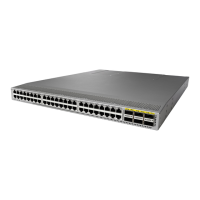Send document comments to nexus3k-docfeedback@cisco.com
13-2
Cisco Nexus 3000 Series NX-OS Unicast Routing Configuration Guide, NX-OS Release 5.0(3)U1(1)
Chapter 13 Configuring VRRP
Information About VRRP
VRRP Operation
A LAN client can determine which router should be the first hop to a particular remote destination by
using a dynamic process or static configuration. Examples of dynamic router discovery are as follows:
• Proxy ARP—The client uses Address Resolution Protocol (ARP) to get the destination it wants to
reach, and a router will respond to the ARP request with its own MAC address.
• Routing protocol—The client listens to dynamic routing protocol updates (for example, from
Routing Information Protocol [RIP]) and forms its own routing table.
• ICMP Router Discovery Protocol (IRDP) client—The client runs an Internet Control Message
Protocol (ICMP) router discovery client.
The disadvantage to dynamic discovery protocols is that they incur some configuration and processing
overhead on the LAN client. Also, in the event of a router failure, the process of switching to another
router can be slow.
An alternative to dynamic discovery protocols is to statically configure a default router on the client.
Although, this approach simplifies client configuration and processing, it creates a single point of
failure. If the default gateway fails, the LAN client is limited to communicating only on the local IP
network segment and is cut off from the rest of the network.
VRRP can solve the static configuration problem by enabling a group of routers (a VRRP group) to share
a single virtual IP address. You can then configure the LAN clients with the virtual IP address as their
default gateway.
Figure 13-1 shows a basic VLAN topology. In this example, Routers A, B, and C form a VRRP group.
The IP address of the group is the same address that was configured for the Ethernet interface of Router
A (10.0.0.1).
Figure 13-1 Basic VRRP Topology
Because the virtual IP address uses the IP address of the physical Ethernet interface of Router A, Router
A is the master (also known as the IP address owner). As the master, Router A owns the virtual IP address
of the VRRP group r and forwards packets sent to this IP address. Clients 1 through 3 are configured
with the default gateway IP address of 10.0.0.1.
Router A
Virtual router
master
Virtual
router group
IP address = 10.0.0.1
Client 1 Client 2 Client 3
10.0.0.1
Router B
Virtual router
backup
10.0.0.2
Router C
Virtual router
backup
10.0.0.3
56623

